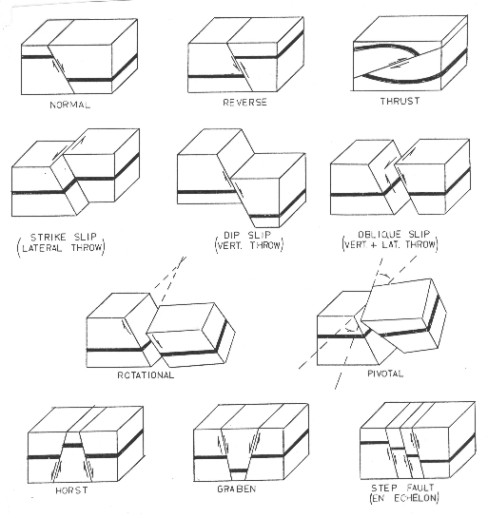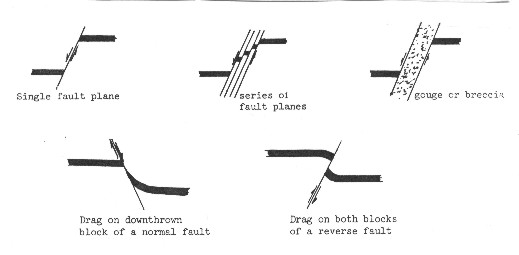|
 Folds
and Faults - ROCKS CAN BEND OR BREAK
Folds
and Faults - ROCKS CAN BEND OR BREAK
Mountains are regions of disturbed or deformed rocks. They are
differentiated into three types according to the nature of the
deformation which created them:
1.
dome mountains result from the upward bending of rocks into the
form of a dome. The Black Hills of South Dakota are a typical
example of a naturally dissected dome mountain.
2.
fold mountains consist of a series of long, more or less parallel
wrinkles, or folds. The mountains of West Virginia and central
Pennsylvania are good examples of fold mountains in the mature
stage of erosion. This type of lateral compressional folding,
whether it occurs in mountain building or on a much more localized
scale in the subsurface, creates structures which may contain
hydrocarbons. These are anticlines, synclines, and monoclines.
3.
block mountains are formed by faulting and uplifting of angular
blocks of rock. Some of the blocks are pushed and tilted at various
angles into block mountains. The depressed blocks between the
uplifted ones are block basins.
 Folds
Folds
Anticlines
are the raised peaks of folds (the tops of the hills) and may
be evident at the surface, although deeply buried anticlines may
be covered by flat lying sediments. Synclines are the valleys
between folds. A monocline is a long, relatively flat, sloping
surface usually with a more or less flat plain at the bottom end
and a flat plateau at the top end.
Formation
dip is the angle relative to horizontal at which the top surface
of a formation rests. The dip direction, or dip azimuth, is the
direction relative to north at which the formation dips downward.
Strike is the direction of a line along the surface at right angles
to the dip direction.

Definitions of folds
A
fold is made of:
1. an axial plane or an axial surface of folding
2. two flanks, or limbs
3. a zone of flexure
4. an axis where the axial plane crosses the rock layers
A fold is described according to:
1. the orientation of the axial surface with respect to vertical:
- symmetrical when the axial plane is vertical
- asymmetrical when the axial surface is oblique
- overturned when the axial surface is oblique, and one flank
has been overturned; i.e., dips in the same direction as the other
flank
- recumbent when the axial surface is horizontal or nearly so,
one flank is overturned
2.
the dip of both flanks with regard to the axial plane;
- anticline when the flanks dip downward away from the axial plane
- syncline when the flanks dip downward toward the axial plane
3.
the direction of the angle of folding:
- convex when the angle of folding points upward (upfold, anticline)
- concave when the angle of folding points downward (downfold,
syncline)
4.
the angle of folding:
- open when the angle of folding is greater than 90 degrees
- closed when the angle of folding is less than 90 degrees
A
dome is a fold where the beds dip in all directions away from
the point of folding. The axial plane may be a warped surface.
 Faults
Faults
The
same type of forces that act on a major scale to build mountains
act in a smaller localized way to create faults. The gravity,
or normal, fault is caused by tensional forces. Removal of compression
allows one block of the earth to move downward with respect to
another.

Definitions of faults
When
compressional forces are exerted, a reverse or thrust fault results.
In a thrust fault, pressure forces cause the hanging wall (the
rock above the fault plane) to move upward and over the top of
the foot wall (the rock below the fault plane). Reverse faults
are similar except that there is no motion of the upper block
along the top of the lower block.
Movement
of either wall in a direction parallel with the fault plane is
called a rift or tear or shear fault.
In
some instances a long and narrow block drops down between two
or more faults, and is called a graben. Blocks that remain raised
between two faults are called horsts. The faults bounding both
grabens and horsts are gravity (or normal) faults.
A
fault is a fracture with relative movement of the two blocks of
rock on either side of the fracture. It is made of:
1. the fracture proper
2. fault plane(s) or fault zone
3. the upper block above the fault plane, called the hanging wall
4. the lower block below the fault plane, called the foot wall
5. a zone of distortion, which may occur on both or either side
of the fault plane, usually called rollover, drag, or gouge
A
fault can be described:
1. according to the relative movements of both blocks with respect
to vertical
- normal when the upper block is downthrown (gravity fault)
- reverse when the upper block is upthrown
2.
according to the relative movement of both blocks with respect
to the dip of the fault plane
- strike-slip when the movement occurs laterally along the strike
of the fault plane (horizontal throw)
- dip-slip when the movement occurs down the dip of the fault
plane (vertical throw)
- oblique-slip when the movement occurs along both the strike
and dip of the fault plane
- rotational when the movement occurs around an axis with rotation
on only one block
- pivotal when both blocks rotate in opposite directions around
a common axis
3.
according to the magnitude of dip of the fault plane
- high angle when the fault plane dips more than 45 degrees
- low angle when the fault plane dips less than 45 degrees
- vertical when the fault plane is vertical
4.
according to the time of occurrence with respect to deposition
- post-depositional when the fault occurs long after deposition
- contemporaneous when the fault grows at the same time as deposition,
also called growth faults
Other
descriptive terms used are:
1. separation: the distance from one bed boundary in one block
to its counterpart in the other.
2.
throw: the vertical component of separation; i.e., separation
measured in a vertical plane normal to the fault plane. The term
45-foot fault means that 45 feet of vertical section are missing
at the well bore (if a normal fault) or 45 feet of section is
repeated (if a reverse fault).
3.
slip: the movement along the fault, being the distance between
two formerly adjacent points. Slip can be in any direction within
the fault plane; same as separation if there is no horizontal
component of movement.
4.
extent: a fault is limited in horizontal and vertical extent by
sudden disappearance against another fault, or against an unconformity,
or by gradual decrease of throw along the fault plane. In rotational
faults, throw decreases in the direction of the plane of rotation.
5.
correlation gaps or repeats: when a well crosses a normal fault,
correlation of the well logs will show a missing section. When
a well crosses a reverse fault, the same formation is crossed
twice, and appears as a repeat section on the log. A reversed
repeat can occur when drilling through a recumbent fold.
6.
drag and rollover: are fold-like deformations of the bedding planes
in the vicinity of a fault and associated with the fault. Such
folding is called drag when it is caused by friction of the two
blocks against each other along the fault. The result is:
- concave folding on the downthrown block.
- convex folding on the upthrown block.

Drag on faults
In
certain regions, normal faulting occurs with reverse drag, or
rollover in the downthrown block. In this configuration, the bedding
planes dip into the fault plane instead of away from it. Rollover
is frequently associated with growth faults; i.e., faulting contemporaneous
with deposition, with greater formation thickness on the downthrown
side of the fault.
|

